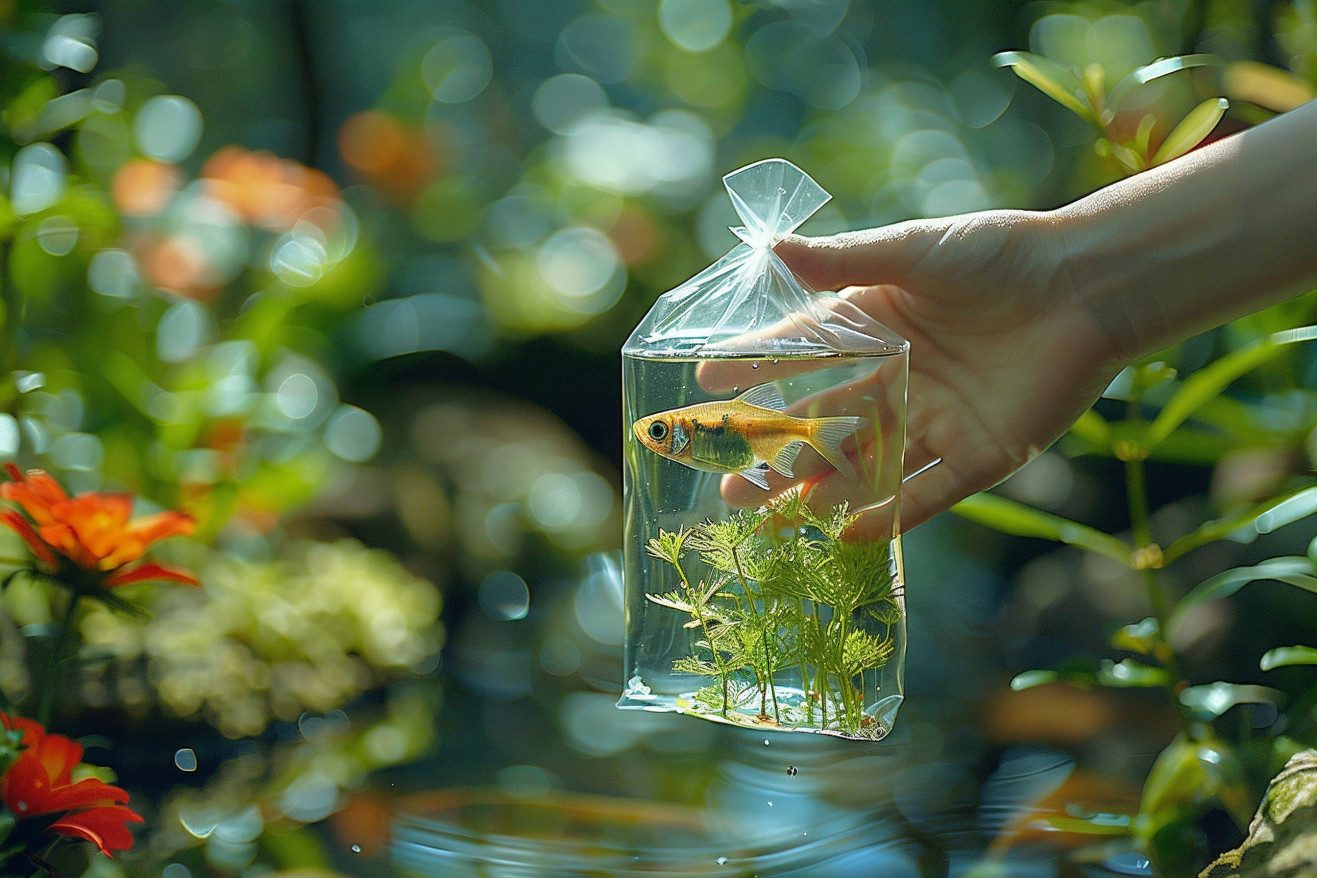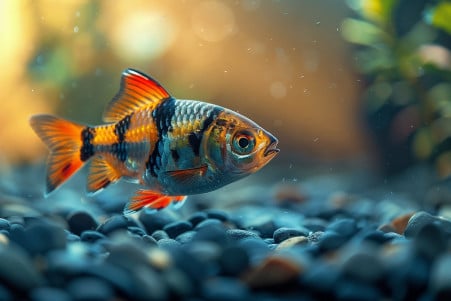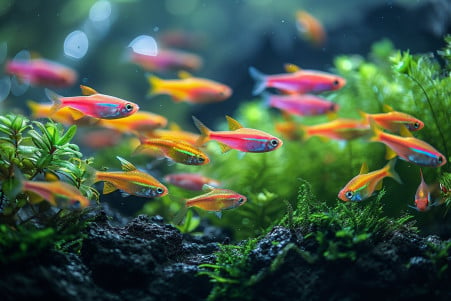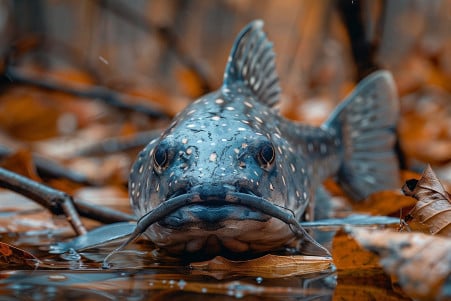How Long Can Fish Live in a Bag? The Science of Safe Transportation
4 April 2024 • Updated 4 April 2024

If you're moving fish, you may be wondering how long they can live in a bag before you need to move them to a tank. Although the exact time can depend on a number of factors, most scientists agree that fish can be in a bag for 7-9 hours at the most if they're packed with an air space and kept cool.
However, even if it's necessary, bagging fish for a short period of time is stressful. This article will go over the scientific literature from aquaculturists, marine biologists, and fish veterinarians to explain the best conditions, time limits, and risks of bagging fish. This information makes it easy to understand how to acclimate fish to their new home so that they can be moved with as little stress as possible.
How long can fish stay in a bag?
Proper Acclimation: Transitioning Fish to a New Environment
Proper acclimation is important when moving new fish to a new aquarium. This is because the water parameters, such as temperature, pH, and salinity, can be quite different, which can lead to a lot of stress and even shock if the fish are just dumped into the new tank. As The Spruce Pets notes, "Most new fish have been killed by pH shock than from any other problem after adding them to an aquarium."
There are two main methods of acclimation that are recommended by professionals. The floating bag method involves floating the sealed bag in the new aquarium for 15-30 minutes to equalize the temperature and then adding small amounts of tank water to the bag every 30-60 minutes. This allows the fish to get used to the new water more gradually.
The drip acclimation method is recommended for fish that have been in the bag for a long time. In this method, the shipping water is put in a separate container and an airline tubing siphon is used to drip aquarium water into the container at a rate of 1 drop per second. The water is then doubled and half of it is removed multiple times over the course of 1-2 hours. This helps to prevent ammonia from building up due to waste in the water.
While acclimating the fish, it's important to keep an eye on the pH difference between the bag water and the tank water. The Spruce Pets advises, "If the difference is more than 0.4 units, slowly add more tank water to the bag to equalize the pH." It's also recommended to use a good dechlorinator like Seachem Prime to detoxify the ammonia and other pollutants that are likely to be in the water after shipping.
If you don't take the time to acclimate your fish slowly and carefully, you could expose them to temperature shock, pH crash, ammonia poisoning, and the transfer of diseases. While it can be time-consuming, the short-term hassle is worth it to ensure the long-term health of your fish. With the right supplies and a careful eye on the instructions, you can make sure that your fish are as comfortable and healthy as possible during their move.
Survival Timeframes: How Long Can Fish Live in a Bag?
Most fish can live for 6-9 hours in a well-prepared bag, according to AquariumStoreDepot. Fish are often bagged for up to 48 hours during shipping, according to Aquariadise.
That said, there are many factors that can affect how long fish can live in a bag. One of the most important is temperature, and even a few degrees below or above the 72-82°F range can be deadly, according to AquariumStoreDepot. Oxygen levels and the buildup of ammonia from fish waste are also important, especially since larger fish and more active fish will use up the bag's resources more quickly.
Aquariadise also notes that larger and older fish are less likely to survive being bagged because they are less able to handle the stress of the experience. That said, using aged water, air pockets, and single bags can help ensure fish can survive in a bag for as long as possible.
How to Pack and Ship Live Fish
If you’re the one shipping live fish, it’s important to follow the right steps to make sure the fish are packed and shipped in a way that maximizes their chances of survival. According to Aquarium Co-Op, the first step is to move the fish to a separate tank and not feed them for 24-48 hours. This will help the fish clear their digestive systems and reduce waste that can build up during shipping.
After the fish have been fasted, they should be bagged using special plastic bags that are made for shipping fish. As wikiHow explains, the bags should be at least 3 mils thick, and the water should be filled to less than halfway to allow for an air pocket. The bags should then be sealed with rubber bands to prevent leaks.
To help control the temperature, the bags of fish should be placed in a shipping box that’s insulated with materials like crumpled newspaper or Styrofoam packing. The C.A.R.E. Forum notes that heat or cold packs can be added to the box to help keep the temperature in the ideal 72-82°F range. In addition, the bags can be filled with pure oxygen or “breather bags” that are designed to help fish breathe in the sealed bags.
Finally, the shipper and recipient should work together to make sure the fish are shipped as quickly as possible, ideally using overnight or express shipping. If these steps are followed, the fish have a much better chance of surviving the trip to their new home.
How to Reduce Stress and Maintain Fish Health During Transport
Live fish transport involves a number of stressors that can have a significant impact on fish health and survival, including high density, physical handling, and poor water quality conditions. The ResearchGate study explains that these stressors can affect physiological processes such as respiration, excretion, and osmoregulation, which can ultimately lead to a loss of homeostasis.
To reduce stress and maintain fish health during transport, experts suggest reducing fish density and stocking fewer fish in larger water volumes. The Pet Age article also recommends lowering the water temperature to reduce metabolic rates and prevent the buildup of waste products. It's also important to closely monitor water quality parameters, such as pH, dissolved oxygen, and ammonia levels, as the MU Extension guide notes.
Sedatives, salt, and water buffers can be used to help reduce stress and stabilize water quality. The Newswise article reports that adding 4 grams of salt per liter of water reduced cortisol levels in transported Nile tilapia. Meanwhile, the Pet Age article suggests using API STRESS COAT, which can reduce stress by up to 40% and improve the fish's protective slime coat.
Most importantly, it's essential to handle the bagged fish carefully and avoid rough handling or shaking. It's also important to watch for signs of stress in the fish, such as erratic swimming or rapid gill movement. These signs can help you catch and address potential problems early. By carefully managing the many stressors that can arise during transport, you can increase the likelihood that the fish will arrive at their destination in good health and condition.
Shipping Live Coral, Aquatic Plants, and Invertebrates
Shipping live coral, aquatic plants, and invertebrates like shrimp and snails requires more than just the standard fish bagging techniques. According to Coral Ever After, the "damp" shipping method, which involves wrapping corals in damp paper towels as opposed to completely submerging them in water, is more successful in ensuring corals survive the shipping process. The ReefKeeping.com article also found that even a small amount of water left in the shipping bag can cause coral fragments to experience rapid tissue necrosis.
Proper handling and packaging is especially important for shipping live coral, aquatic plants, and invertebrates. According to the ResearchGate study, coral fragments are more likely to survive shipping than whole colonies. Soft corals, gorgonians, and zoanthids should be removed from their substrate with care. Temperature is another important consideration, and the study recommends using insulated shipping containers and being careful with the use of heat and ice packs to ensure the temperature stays within the proper range.
Different coral and invertebrate species may have different shipping needs. For example, the ReefKeeping.com article found that Oculina corals were more sensitive to "dry" shipping methods than other species. It's important to do your homework and work with experienced shippers to ensure the best results when shipping more sensitive marine life. It's also important to make sure you have the proper permits and are in compliance with local regulations, as most areas have strict rules about collecting and importing live coral and other protected marine life.
Legal Requirements and Regulations for Shipping Aquatic Life
The eCFR specifies a number of rules for the transportation and labeling of packages containing live fish or wildlife. For example, all packages must be marked on the outside with the name and address of the shipper and consignee, as well as an accurate list of the contents by species and number.
That said, the eCFR does allow for some flexibility with this marking requirement. Instead of listing the specific species and number, packages can be marked with the general terms "fish" or "wildlife", or the common species name, as long as the full details are listed on an accompanying document such as an invoice. Shippers with a valid wildlife import/export license can also mark packages with their license number.
The AVMA explains that some aquatic animals, such as piranha, are regulated, and shipping them may require special permits or documentation. Importation into some countries or states may also require a certificate of veterinary inspection or quarantine.
In addition, the UPS website explains that shipping companies have their own rules about what live animals they will and will not ship. For example, UPS only ships amphibians, fish, and reptiles, and will not ship any animals that are endangered, venomous, or pose a threat to human health.
It's important to understand and follow the many legal requirements for shipping aquatic life to ensure a safe and compliant shipping process. Thorough research and working with authorities, veterinarians, and shipping companies can help ensure that you're able to successfully navigate these regulations.
Conclusion: What You Should Know About Transporting Fish
The maximum recommended time that fish can be kept in bags is typically around 7-9 hours, although proper preparation can extend this to up to 48 hours for longer trips. Proper acclimation is essential to ensure that fish are successfully introduced to a new tank since sudden changes in water parameters can be deadly.
When it comes to packing and shipping live fish, the best practices include quarantining the fish in advance, using the right size and type of bag with air, and controlling temperature with insulation and heat or ice packs. It’s also important to reduce stress and maintain water quality by lowering the density, temperature, and water level.
Finally, make sure to check for any legal considerations or restrictions when transporting fish, as some species may require permits. By keeping these tips in mind and focusing on the well-being of the fish, you can help ensure that the transport is successful and as stress-free as possible.


